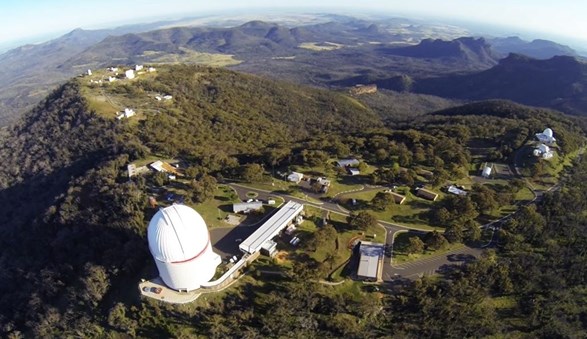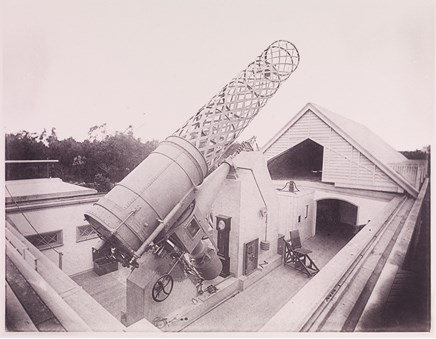How do telescopes work?
Telescopes collect and magnify the light from distant objects.
The problem with observing objects in the night sky is that they are so far away and therefore appear extremely faint. The more light that can be collected with a telescope, the better we can see these objects. The light collecting ability of a telescope is determined by its diameter, also known as its aperture.
There are three main types of optical telescopes and these differ in the way that they collect light to form an image:
- Refracting telescopes were the first type of telescope and their invention is attributed to a Dutch lensmaker, Hans Lippershey in 1608. They have a curved lens at one end that focuses the light down a long tube towards a second lens, called the eyepiece, which magnifies the image. The astronomer, Galileo, was the first person to observe the night sky with a telescope, discovering the craters on the Moon, the rings of Saturn, and Jupiter’s four largest moons (Io, Europa, Ganymede and Callisto).
- Reflecting telescopes are sometimes called Newtonian telescopes after their inventor Isaac Newton who built the first one in 1668. They use mirrors to collect and focus the light towards the eyepiece. Mirrors are lighter than lenses and they are also easier to shape into a smooth and perfect surface. If there are any flaws in a telescope’s optics (eg. the mirrors or lenses) then the image created will appear warped or out-of-focus and blurry.
- Catadioptric telescopes were invented in the 1930s and are the most modern design of telescopes. They combine both lenses and mirrors to focus the light towards the eyepiece. These telescopes are typically short and stubby and this compact design makes them easy to transport and handle. The arrangement of the optics (eg the lenses and mirrors) can make the light ‘fold’ in on itself, bringing it to a focus without having to travel the full-length of a long telescope tube as required by traditional telescopes.
For all telescopes, it is the eyepiece that determines how much an image is magnified. Some telescopes come with a variety of eyepieces so that you can change the magnification. The thing to note is that as the magnification is increased, the viewing area of the telescope is decreased. Therefore, when first trying to centre an object in a telescope, it is best to use the eyepiece with the lowest magnification so that the biggest area is available in which to find the object. Once the object is centred, then change to a higher magnification eyepiece to see more detail.
It is very important to have a sturdy telescope mount (or stand) to keep your telescope stable and to help you point and move your telescope smoothly. Remember that the stars are always moving across the sky, rising in the East and setting in the West. Therefore to keep an object in view for longer than a few minutes, it is necessary to make slight adjustments to the position of the telescope.
There are two types of mounts that are generally used for telescopes:
- Alt-azimuth mounts use simple up-down (altitude) and side-to-side (azimuth) movements to point the telescope. However, to follow the motion of the stars using this telescope it is necessary to move the telescope in both directions.
- Equatorial mounts are slightly more complicated as the movements are based on rotations. However, they can follow the stars across the sky with a single movement and are easily equipped with motors that will automatically move the telescope to counteract the rotation of the Earth and keep an object in view for long periods of time.
Choosing a particular telescope depends on your individual needs. Things to consider include cost, portability, and useability. In particular you need to think about what you hope to view with your telescope.
A good place to start is to purchase a quality pair of binoculars. Binoculars are a smaller version of a refracting telescope. For the amount of money you would pay for a poor quality telescope, you can buy binoculars with excellent optics. A good pair of binoculars will allow you to see the craters of the Moon, the four biggest moons of Jupiter and five to ten times as many stars as you would see with the naked eye.
Other good investments are books or magazines that have monthly star charts. These can help you identify the main constellations and locate the brighter stars. Knowing your night sky will make it much easier to find particular objects with your telescope or binoculars.
If you are serious about astronomy after using binoculars, then consider purchasing a telescope. A good way to decide what type of telescope you need is to ‘test drive’ some telescopes first. Some amateur astronomy clubs hold viewing nights that are open to the public, providing an opportunity to try different telescope types.
Cost is often an important factor when choosing a telescope. In general, reflectors are less expensive than refractors of the same size because mirrors are cheaper to make than lenses. However, refractors usually provide slightly sharper images than reflectors. Amateur astronomers who like to view fine details on planets often prefer refractors; those who like to look at faint deep-sky objects use reflectors.
Big is not always necessarily better. The bigger the diameter of the telescope the more light you will collect, so the images are brighter and can be viewed with eyepieces of higher magnification. However, that doesn’t mean small telescopes aren't worth buying. Even an 8cm (3 inch) refractor can reveal enough of the Universe to keep you entertained for years.
It is also a good idea to choose a telescope that is portable. A big telescope, though exciting at first, can quickly become a burden to set up. The best telescope is not the biggest, or even the one with the best optics, but the one you are most likely to use more often.
Finally, if you are interested in taking photographs of astronomical objects you need to consider that these photographs require long exposure times. Good astrophotography requires a telescope with a sturdy equatorial mount and a motor drive to ‘track’ the stars. This will insure that the object of the photograph remains in a central position.

